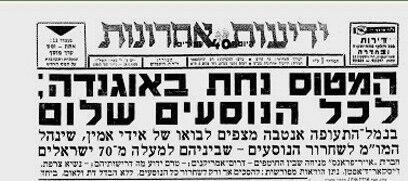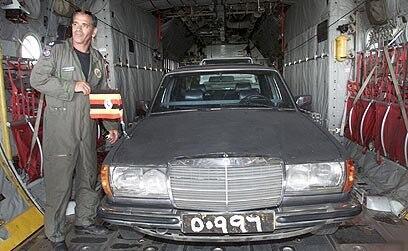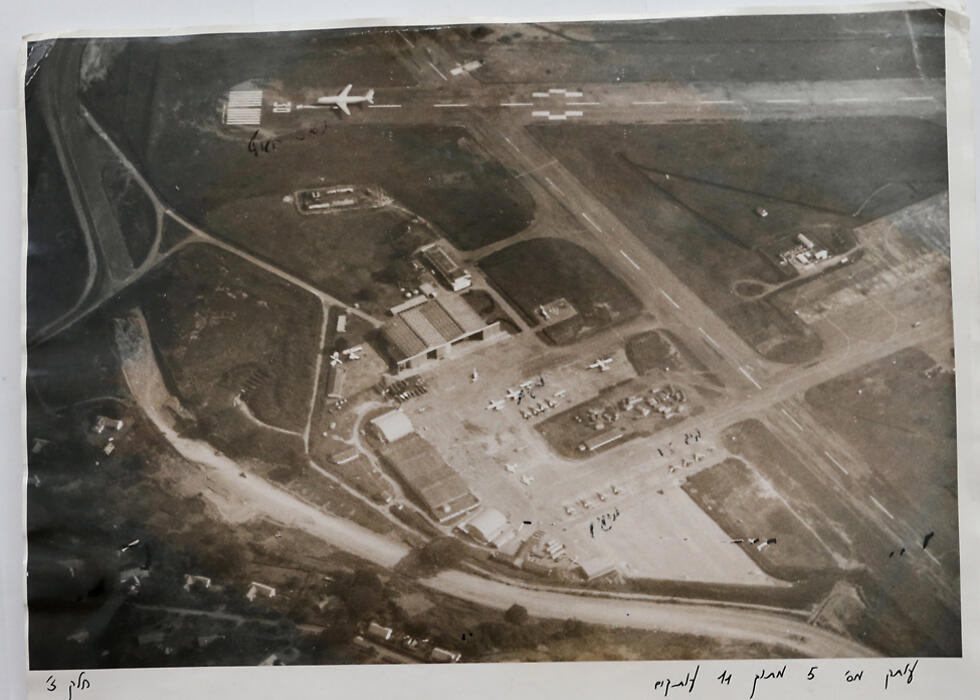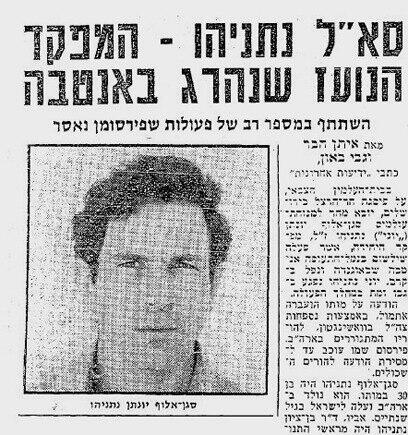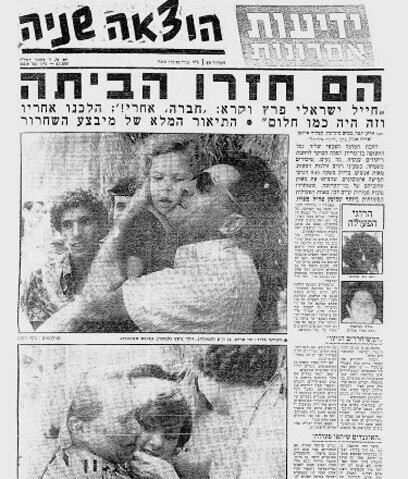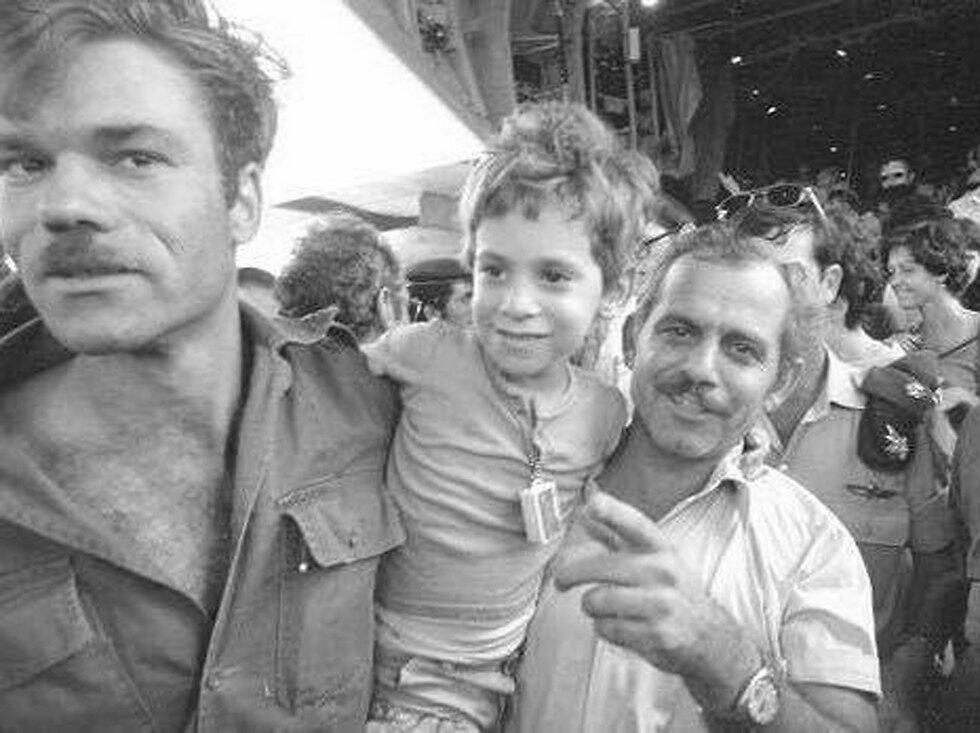This was one of the most impressive and significant operations in the history of the State of Israel. 47 years ago this month, four Hercules planes took off on a clandestine mission to Uganda to release dozens of hostages in an operation that earned a place of honor in Israel's hall of fame.
More stories:
Air France Flight 139 took off from Ben Gurion Airport to Paris on June 27, 1976, without any disruptions. However, it did not reach its destination. Palestinian and German hijackers who boarded the stopover in Athens hijacked the plane, with 206 passengers and crew members, and directed the pilot to fly to Libya and then to Uganda.
10 View gallery
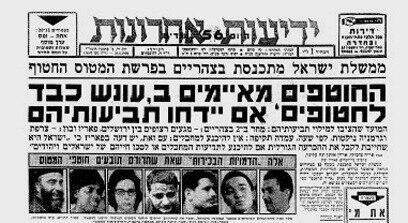

Hijackers threaten 'severe punishment on the hostages'
(Photo: Yedioth Ahronoth Archives)
Upon landing in Entebbe, the plane was taken to the old terminal, about a kilometer and a half away from the active terminal, with only about 20 minutes of fuel left. Ugandan President Idi Amin arrived to meet the hijackers and the hostages. Wearing the IDF paratroopers' wings on his uniform, he was asked about his friends, like Israel’s then-defense minister Moshe Dayan, and told the hijackers, "You are my friends and guests."
The hijackers demanded the release of dozens of terrorists imprisoned in Israel and other European countries. Later, they issued an ultimatum to the governments of Israel, France and West Germany: if 53 terrorists were not released by July 1 at 2 pm, they would inflict "severe punishment on the hostages."
Among their demands was the release of Kozo Okamoto, the Japanese terrorist involved in the Lod Airport massacre in May 1972, in which 24 people were killed. Okamoto was later released as part of the Jibril deal with the Popular Front for the Liberation of Palestine – General Command (PFLP-GC), despite being sentenced to 13 life sentences.
Before the end of the ultimatum, the hijackers separated the Jewish passengers from the non-Jewish passengers. The German hijacker, who was responsible for the selection, read a list of 83 Jews in a heavy German accent and ordered all Israelis to take their luggage and move to the adjacent room. The German hijacker, described as the cruelest among the hijackers, warned: "Our reaction will be very cruel." Some of the non-Jewish hostages returned to Paris on the same day.
Covert operation and losing the element of surprise
Israel refused to comply with the hijackers' demands and instead take action. On July 3, 1976, even before the plan was officially approved in a government meeting, four Hercules planes took off from the Sharm El-Sheikh Airport. Around 200 commandos were on board the planes, led by Brigadier General and the future IDF chief of staff Dan Shomron.
"The first plane landed seven minutes before the others. We planned it so that one plane would land alone, and then we could maintain the element of surprise without disturbing the airfield," says Colonel Muki Betser, who was the deputy of Yoni Netanyahu, head of the elite Sayeret Matkal commando unit. "The first plane carried 34 fighters in Mercedes and two Land Rovers, disguised and with Ugandan license plates."
The raiding force, under Netanyahu’s command, primarily composed of Sayeret Matkal fighters, began moving toward the terminal where the hostages were held. "We moved with full lights on, approached and realized that there were about ten armed hijackers, while four or six were in the terminal in the main hall, guarding the Israelis. There was also an observation tower with hijackers, Ugandans or both," Betser recalled.
"The plan was as follows – we would arrive, a force that we would immediately position would engage with an RPG on the observation tower, and the force under my command, consisting of five squads, would simultaneously breach all entrances in an attempt to eliminate the hijackers in one blow.
As the commandos approached the old terminal, they suddenly saw dozens of Ugandan soldiers, who were not very alert. "No one thought of a military operation, certainly not them. Two stood at the front – one fell, and one remained. He raised his weapon and shouted 'advance,' which is like shouting 'password.' I've been in Uganda, training paratroopers, and they did this to me every day.
Then Yoni decided to engage that soldier, against my opinion. I told him, 'Yoni, leave it, it's just a drill,' but he hesitated for a moment, and they shot him with a silencer." The soldier fell, and when he tried to stand up again, the commandos opened fire on him. "We lost the element of surprise," Betser concluded.
‘Yoni's hit, I’m taking command’
Shooting the Ugandan soldier wasn't the only surprise the commandos faced. "We landed in the wrong place, a little earlier than planned. We all ran to breach the entrances, got a bit entangled with each other and forced our way inside. Amir went in first, Amnon second and I was in the middle. He killed the hijacker on the right, Amnon and I killed the German man and woman, and we had a loudspeaker blaring in Hebrew and English, ‘Stay down! Stay down! We are Israeli soldiers’.”
"Suddenly, from among the hostages, a hijacker appeared and raised his weapon, but before he could shoot, Amos and I killed him with a volley of bullets, and he died," Betser recounted. "At that moment, someone carefully rose from the hostages, someone I recognized, and said, 'You killed everyone here, the rest are in the VIP room.' A second later, Giora Zussman told me, 'Muki, the mission is accomplished.'"
Betser decided to update his commander Yoni Netanyahu that the hijackers had been neutralized. "I called Yoni, who was standing outside the control tower, and I tried to reach him through the communication device, but he didn't respond. The second time, I said, 'Yoni, mission accomplished,' and he still didn't answer. On the third attempt, Tamir Pardo, who would later head the Mossad, shouted to me on the line, 'Yoni is hit, Yoni is hit.'"
"I rushed outside, saw Yoni lying on the floor with a bullet wound in the upper chest. He was unconscious. Immediately, I informed all the forces, ‘Yoni's hit, I’m taking command’."
‘They returned home’
The astonished hostages were swiftly airlifted on Israeli Air Force planes. The entire operation on Ugandan soil was executed in just 51 minutes. This daring and unprecedented mission, seemingly like none before anywhere else, left the authorities in Uganda dumbfounded. On the day of the operation, the Ugandans reportedly remained oblivious to the events unfolding beneath their noses for quite some time after the operation.
10 View gallery


Idi Amin in a phone call to former IDF chief Chaim Barlev: 'What did you do to me? I treated the Israelis well!'
(Photo: Yedioth Ahronoth Archives)
10 View gallery
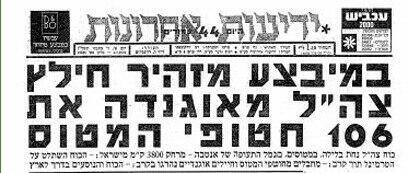

'IDF rescues 106 hostages in a successful operation in Uganda'
(Photo: Yedioth Ahronoth Archives)
The midday edition of Ynetnews’ sister publication Yedioth Ahronoth reported on July 4, "In a daring operation, the IDF rescued the 106 passengers from the hijacked plane in Uganda." In the subheading, it was written, "IDF force lands at night at the Entebbe airport - 3,800 km from Israel. The force captured the terminal in a battle. Hijackers and Ugandan soldiers were killed in the fight, and the force and the passengers were on their way back to Israel."
The second edition, also published that day, was more joyful. "They returned home" read the main headline. One of the released hostages told the newspaper, "An Israeli soldier broke in and yelled, ‘Guys, follow me!' We followed him, and it felt like a dream."
The military compound near Ben Gurion Airport turned into a giant dance floor, where joyful and teary-eyed relatives of the hostages who had been waiting for the Hercules planes to land moved in ecstasy. Hundreds of people danced in circles at the center of the square, waving national flags. They couldn't contain their happiness. Elders were lifted on the shoulders of dancing youths while blowing trumpets and singing Am Yisrael Chai and David Melech Yisrael.
Later, the soldiers were celebrated with a festive feast. A red carpet was laid out, and the attendees welcomed them with applause. "It was like a dream," said a young officer. Then-prime minister Yitzhak Rabin said, "Every Israeli is currently engaged in battle. Even when he travels abroad, he is essentially a soldier fighting against terror, perhaps without realizing it."
'One of Israel's finest'
three civilians were killed in the rescue operation - Ida Borochovitch, killed by terrorist fire; Pasco Cohen, who was killed in the shootout and Jean-Jacques Maimoni, who was accidentally shot by IDF soldiers. Dora Bloch, who felt unwell a few days before the operation, was taken to a hospital in Uganda, where she was also murdered. Her body was only returned to Israel in June 1979. IDF soldier Sorin Hershko was seriously injured in the operation and left paralyzed.
10 View gallery
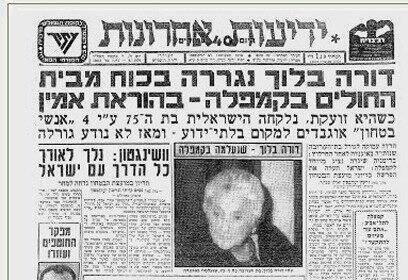

'Dora Bloch was dragged out forcefully from the hospital in Kampala under the orders of Amin'
(Photo: Yedioth Ahronoth Archives)
The news f the death of Yoni Netanyahu, the revered commander of the Sayeret Matkal, was only published the day after the operation due to his parents being in the United States at the time. Yedioth Ahronoth mentioned that his father, Prof. Ben-Zion Netanyahu, was a leader of the Revisionist movement and close associates of Ze'ev Jabotinsky. It was also written that his two younger brothers, Yair and Benjamin, enlisted in combat units like their older brother.
Yoni Netanyahu was laid to rest on Mount Herzl. Among the many mourners were Prime Minister Rabin and Defense Minister Shimon Peres. Peres eulogized him, saying, “I grieve for you, Yonatan my brother; you were very dear to me. Your love was wonderful.”
Peres emphasized that the Entebbe operation was unprecedented in military history, proving that Israel is capable not only of defending its borders but also of showing extraordinary audacity in the face of extreme terrorism. "The hardest moment was when we received the news of the death of one of Israel's finest, one of the bravest of Israel's fighters, one of the most promising commanders in the IDF."


